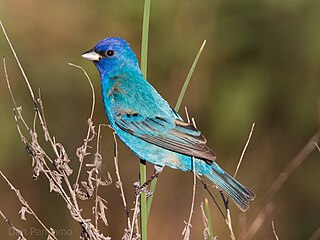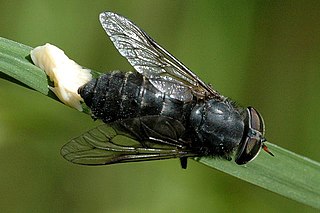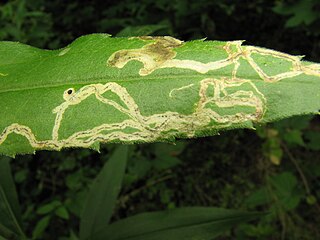
Flies are insects of the order Diptera, the name being derived from the Greek δι- di- "two", and πτερόν pteron "wing". Insects of this order use only a single pair of wings to fly, the hindwings having evolved into advanced mechanosensory organs known as halteres, which act as high-speed sensors of rotational movement and allow dipterans to perform advanced aerobatics. Diptera is a large order containing an estimated 1,000,000 species including horse-flies, crane flies, hoverflies, mosquitoes and others, although only about 125,000 species have been described.

A crane fly is any member of the dipteran superfamily Tipuloidea, which contains the living families Cylindrotomidae, Limoniidae, Pediciidae and Tipulidae, as well as several extinct families. "Winter crane flies", members of the family Trichoceridae, are sufficiently different from the typical crane flies of Tipuloidea to be excluded from the superfamily Tipuloidea, and are placed as their sister group within Tipulomorpha.

The indigo bunting is a small seed-eating bird in the cardinal family, Cardinalidae. It is migratory, ranging from southern Canada to northern Florida during the breeding season, and from southern Florida to northern South America during the winter. It often migrates by night, using the stars to navigate. Its habitat is farmland, brush areas, and open woodland. The indigo bunting is closely related to the lazuli bunting and interbreeds with the species where their ranges overlap.

The southern hawker or blue hawker is a species of hawker dragonfly.

The masked flowerpiercer is a species of bird in the tanager family, Thraupidae. It is found in humid montane forest and scrub in Venezuela, Colombia, Ecuador, Peru and Bolivia. Flowerpiercers got their name from the fact that they have a sharp hook on the tip of their upper mandible which they use to slice open the base of flowers to get at the nectar.

Hybomitra is a genus of horse flies in the family Tabanidae. There are at least 240 described species in Hybomitra.

Campiglossa is a genus of fruit flies in the family Tephritidae. There are at least 190 described species in Campiglossa.
Laphria virginica is a species of robber flies in the genus Laphria, in the order Diptera ("flies").
Aphoebantus scalaris is a species in the family Bombyliidae, in the order Diptera ("flies").

Allograpta exotica is a species in the family Syrphidae, in the order Diptera ("flies"). Larvae are often predators of aphids. Their life cycle from egg to adults is around 15 days, with adults living for approximately 10 days.
Dalmannia nigriceps is a species in the family Conopidae, in the order Diptera ("flies").

Phytomyza opacae is a species in the family Agromyzidae, in the order Diptera ("flies"). Its host plants are Ilex myrtifolia, Ilex cassine, Ilex opaca, and Ilex amelanchier.
Paravilla is a genus of bee flies. There are at least 50 described species in Paravilla.

Phytomyza is a genus of leaf miner flies in the family Agromyzidae. At least 170 described species are placed in Phytomyza. The type species is Phytomyza flaveola, described by Carl Fallén in 1810.
Milesiina is a subtribe of syrphid flies in the family Syrphidae. There are at least 14 described species in Milesiina.
Oreogetonidae is a family of flies. There is at least one genus, Oreogeton, and at least 30 described species in Oreogetonidae.

Senopterina is a genus of signal flies. There are about 17 described species in Senopterina.

Hemisphaerota cyanea, known generally as palmetto tortoise beetle, is a species of leaf beetle in the family Chrysomelidae. Other names include the Florida tortoise beetle and iridescent blue chrysomelid beetle. It is native to the southeastern United States, from North Carolina, south to Florida, and west to Mississippi. It is introduced to southern Texas.
Sintoria is a genus of robber flies. There are about six described species in Sintoria.
Drosophila hemipeza is an endangered species of Hawaiian fly in the family Drosophilidae. This species is a member of the planitiba subgroup of the picture-wing clade of Hawaiian Drosophila.












